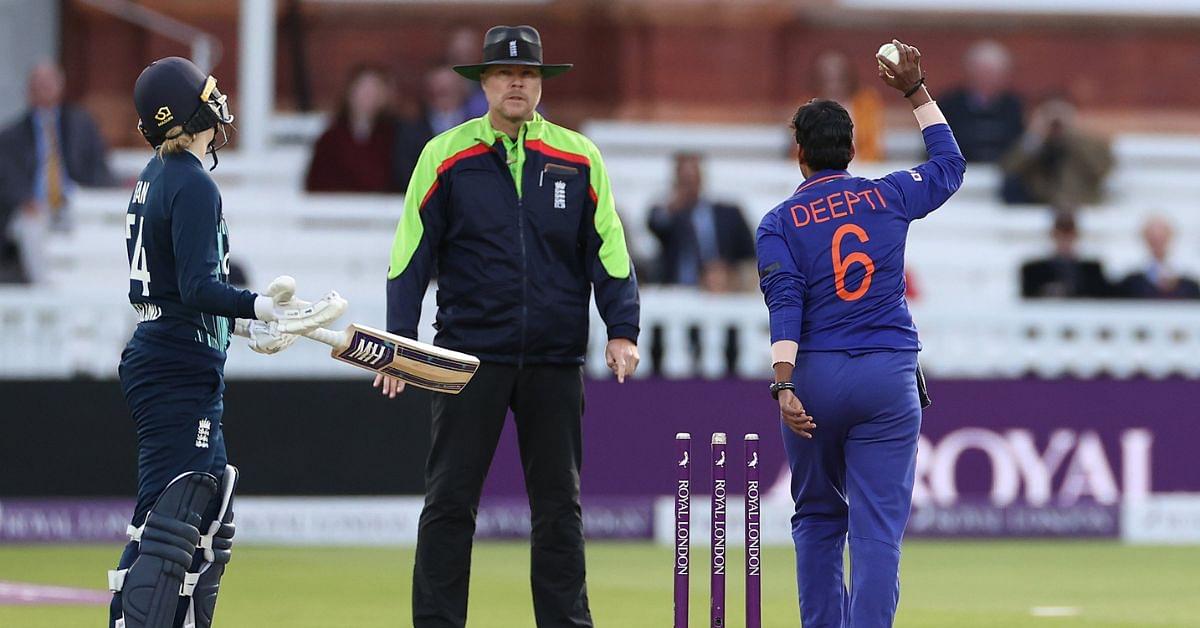Mankading in cricket rules new updated by ICC: ICC recently updated the rules regarding so-called “Mankad” incidents.
Advertisement
The 3rd ODI between India Women and England Women at the Lord’s has sparked yet another controversy. The so-called “Mankad” term has struck the cricketing world yet again. India Women scored 169 runs in their first innings, and England Women were 153-9, and the incident happened on the 3rd ball of the 44th over.
Deepti Sharma was bowling for the Indian team, and English batter Charlotte Dean was at the non-striker’s end. When Deepti was bowling, Dean crossed the crease before the ball was released from Deepti’s hand, and Deepti ran her out. India decided to go with the appeal, and 3rd umpire called Dean out and India won the match.
The whole crowd was booing the Indian team, and this was sure that this incident will spark social media. Players like R Ashwin, Sam Billings, James Anderson, James Taylor, etc were engaged in a debate regarding the nature of the incident.
The moment India claimed their first ODI series win vs England in 20 years 🥺
Deepti Sharma ran Charlie Dean out at the non-striker’s end in her delivery stride, to give India a 3-0 sweep and @JhulanG10 a victorious farewell ✨#ENGvIND #SonySportsNetwork #SirfSonyPeDikhega pic.twitter.com/Ai2hWxBPlo
— Sony Sports Network (@SonySportsNetwk) September 25, 2022
Mankading in cricket rules new updated by ICC
Law 41.16.1 clearly says that if a non-striker is out of the crease before the “ball comes into play”, the bowler has every right to run that batter out. However, it was under unfair means earlier, but the new MCC rules have changed that thing as well.
Law 41.16.1 states that “If the non-striker is out of his/her ground at any time from the moment the ball comes into play until the instant when the bowler would normally have been expected to release the ball, the non-striker is liable to be Run out. In these circumstances, the non-striker will be out Run out if he/she is out of his/her ground when his/her wicket is put down by the bowler throwing the ball at the stumps or by the bowler’s hand holding the ball, whether or not the ball is subsequently delivered.”
ALSO READ: Jos Buttler and R Ashwin Mankad Controversy in IPL
However, in the new rules, MCC has clearly stated that it won’t come in the unfair means from now on, and it will be called a legitimate run-out dismissal. So, the debate is certainly over that whether it is a legitimate dismissal or not, it is clear that this is a normal run-out dismissal like any other mode of taking a wicket.
It is also unfair to use the word “Mankad” in these dismissals. Veenu Mankad is a player who should be remembered for his performances on the field, and not for this kind of controversy. A run-out at the non-striker’s end is the perfect way to acknowledge dismissals like these.
UPDATE: MCC has amended the law to provide better clarity around the above mentioned term “bowler would normally have been expected to release the ball”. Removing ambiguity around its exact meaning, everyone is advised to interpret it as “the highest point in that bowler’s action”.




